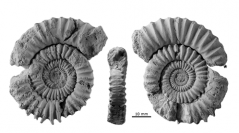

 Comptes Rendus Palevol
12 (3) - Pages 137-148
Comptes Rendus Palevol
12 (3) - Pages 137-148A study of the ammonite assemblages from the “Oolithe ferrugineuse de Bayeux” Formation of Bajocian age is presented herein. The section at the locality of Maizet shows a high level of stratigraphic condensation, and taphonomic reworking is common within the sequence. All the ammonites being studied are classified herein as having been reworked, transported or displaced on the sea-floor prior to burial, and as such, are determined taphonomically as being resedimented or reelaborated fossil elements. Seven evidences of reelaboration within the sequence under investigation are detailed here. The palaeontological units, so-called taphorecords, characterized by distinctive taphonomic features, are used to directly or indirectly assign beds to biochronostratigraphic units. In addition, identification of taphorecord relationships regarding successive or contemporaneous deposition allows their registratic succession and order of depositional events to be inferred. The latter may be deduced on the basis of bed succession or by reference to stratigraphical intervals that now are only represented in the stratigraphic column by fossils. Deposition by tractional currents and winnowing is indicated by sharp bed-base and by reworked fossil elements. Biochronostratigraphic correlation with other sections of the inland Bajocian successions in the Calvados area (Bretteville, Feuguerolles) highlights a common depositional evolution that may be related to an eastward-deepening carbonate ramp.
Ammonites, Bajocian, Calvados, Taphorecords, Biochronology, Registratic succession